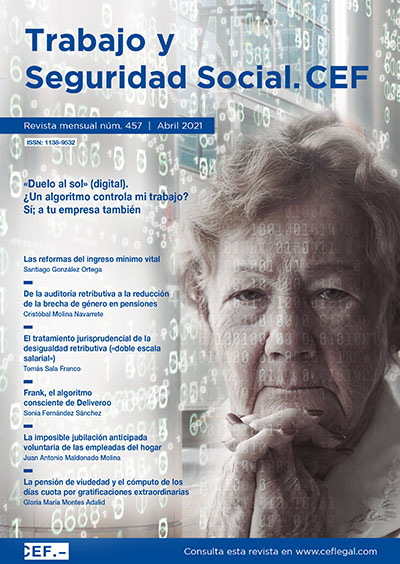From salary auditing to reducing the gender gap in pensions: a new corrective supplement to take seriously?
DOI:
https://doi.org/10.51302/rtss.2021.2376Keywords:
wage gap, gender equality, gender gap in pensions, widow’s pension, multiple discriminationAbstract
Gender gaps in public pensions constitute a serious qualitative and quantitative imbalance of Social Security systems in the European Union, and certainly also in Spain. The main cause is not in the system, but in the gender gaps in the labor market, including the wage gap. Some of the measures tested by Spanish law have been opposed by the Court of Justice of the European Union. For this reason, Spanish law has approved a new supplement for contributory pensions, with the aim of reducing the gender gap, reforming art. 60 of the consolidated text of the General Law on Social Security (by RDL 3/2021, February 2).
This new contributory pension supplement, which does not exclude men, but will mainly benefit women (at least 8 out of 10 recipients will be women), is less costly for the State and somewhat more effective in reducing the gender gap in pensions than the previous one. But this regulation raises some application problems, and it will also not be enough to reduce the gender gap in a relevant and fast way. This study gives an account of its main legal developments, as well as other issues that have to do with the progress and resistance of the courts to remove gender gaps in Social Security.
Downloads
References
Beltrán de Heredia Ruiz, Ignasi. (17 de marzo de 2021). ¿De qué exonera la certificación negativa del art. 42 ET? (a propósito de la STSC-A 03/02/21). Una mirada crítica a las relaciones laborales. https://ignasibeltran.com/2021/03/17/de-que-exonera-la-certificacion-negativa-del-art-42-et-a-proposito-de-la-stsc-a-03-02-21/
Ferrando García, Francisca María. (2018). La discriminación múltiple e interseccional en el ámbito laboral. Revista de Trabajo y Seguridad Social. CEF, 428, 19-54.
García Campá, Santiago. (2021). El registro salarial o retributivo. Revista de Trabajo y Seguridad Social. CEF, 455, 79-115.
Martínez Moreno, Carolina. (2019). Brecha salarial de género y discriminación retributiva: causas y vías para combatirlas. Bomarzo.
Miñarro Yanini, Margarita y Molina Navarrete, Cristóbal. (8 de marzo de 2021). ¿Libertad de empresa vs. equidad de género?: el TS perpetúa brechas retributivas (y de pensiones). CEF-Laboral-Social. https://www.laboral-social.com/la-revista-trabajo-seguridad-social-cef-conmemora-8M-2021.html
Molina Navarrete, Cristóbal. (2020). La doctrina jurisprudencial por discriminación de género en el orden social. Wolters Kluwer.
Moreno Romero, Francisca. (2021). La anómala situación del complemento por maternidad y su impacto en el sistema de pensiones: apunte sobre su reforma por Real Decreto-Ley 3/2021. Revista General de Derecho del Trabajo y de la Seguridad Social, 58.
Rey Martínez, Fernando. (2008). La discriminación múltiple, una realidad antigua, un concepto nuevo. Revista Española de Derecho Constitucional, 84, 251-283. https://dialnet.unirioja.es/descarga/articulo/2775864.pdf
Rojo Torrecilla, Eduardo. (4 de marzo de 2021). El matrimonio gitano no permite el acceso a la pensión de viudedad según el TC. Notas a la Sentencia de 25 de enero de 2021, y la oportunidad nuevamente perdida para abordar la discriminación múltiple o interseccional. Valedora do Pobo. Galicia. https://www.valedordopobo.gal/es/essential_grid/el-matrimonio-gitano-no-permite-el-acceso-a-la-pension-de-viudedad-segun-el-tc-notas-a-la-sentencia-de-25-de-enero-de-2021-y-la-oportunidad-nuevamente-perdida-para-abordar-la-discriminacion-multiple/#_ftn2


















